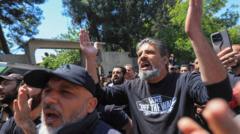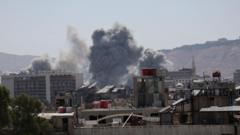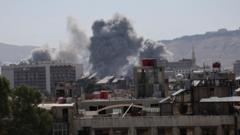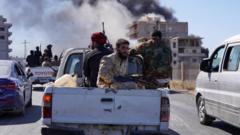The Druze community in Syria is confronted with escalating sectarian violence and a deteriorating relationship with the government. Recent attacks have left many questioning their safety and trust, as they navigate a precarious situation amidst fears of a Sunni-dominated regime.
Druze Community in Syria Faces Growing Threats Amidst Sectarian Violence

Druze Community in Syria Faces Growing Threats Amidst Sectarian Violence
As sectarian tensions rise in post-war Syria, the Druze community expresses fears for their safety, grappling with a changing political landscape and increasing violence.
In the Damascus suburb of Ashrafiyat Sahnaya, Lama al-Hassanieh found herself in terror as gunfire erupted outside her home, forcing her to hide in her bathroom. The chaos stemmed from groups of armed men dressed in military-style uniforms invoking threats against the Druze community while displaying heavy weapons. This marked a stark reminder for many in the Druze community, whose faith diverges from mainstream Islam, highlighting their historically vulnerable status in Syrian society.
The Druze, often characterized by their commitment to a specific set of beliefs that include elements of Shia Islam, historically walked a tightrope under the regime of former President Bashar al-Assad. Many within the community chose to align themselves with the state, hoping to insulate themselves from the widespread sectarian conflict that defined Syria’s civil war, which extends back over 13 years. Initially, Assad appeared to protect Druze interests amidst the turmoil, facilitating a reluctant alliance that allowed them to operate their own militias to safeguard their neighborhoods while avoiding confrontation with pro-government forces.
However, with the arrival of Sunni Islamist-led factions, that fragile security is crumbling. Recent violence against Druze neighborhoods, triggered by allegations against a Druze religious leader and aggravated by an inflammatory video urging revenge against Druze individuals, led to widespread unrest. Reports indicate that clashes resulted in at least 137 fatalities, deepening the fissures between sectarian groups.
Among those caught in the violent crossfire was another individual named Lama, a pharmacy student poised to graduate, whose life was upended as armed assailants besieged her community. Under intense shelling, she recalled the harrowing moments as her family struggled against alarming odds to seek safety. The clashes extended beyond her village, impacting her educational institution, where Druze students faced brutal assaults amid rising sectarian tensions.
The assurance from the government that the assaults stemmed from unaffiliated entities did little to restore faith among Druze leaders and their families. Many express disillusionment with Syria's state apparatus, feeling abandoned during their time of need. The communities are now left with enduring scars of mistrust, including past acquaintances who turned cold or hostile during these desperate hours.
Now, as some Druze individuals like Hadi Abou Hassoun mobilize to protect their neighborhoods, they confront ambushes and violence. Hadi himself suffered serious injuries while volunteering. The atmosphere among the Druze community is mixed; while some perceive a return to calm, an underlying nervousness continues to loom over them.
Israel’s involvement, with airstrikes said to protect the Druze from aggressors, adds an additional layer of complexity in a deeply fractured society struggling to reclaim its unity. Despite these foreign interventions, many Druze like Lama are left questioning their place and future in a country rapidly shifting towards a potentially intolerant order.
As Druze citizens express the longing for acknowledgment and equality within the broader Syrian population, they seek assurances of protection and justice—a fundamental need as they strive to carve out their identity within a landscape marked by conflict and division. The plea for accountability remains loud, underscoring the urgent necessity for dialogue and resolution in a time of increasing peril.


















